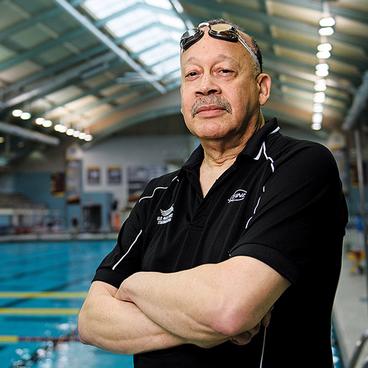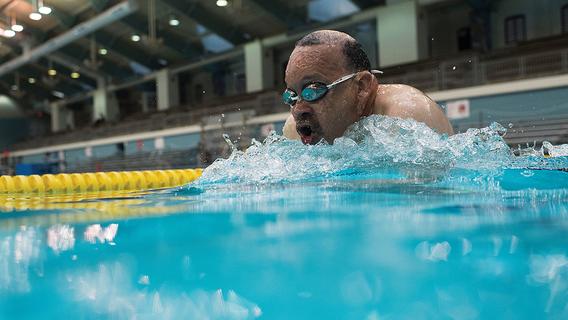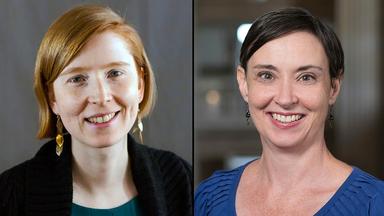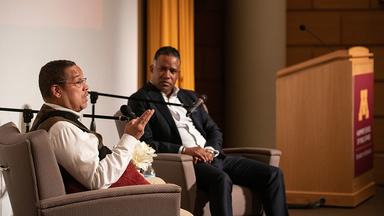Humphrey School Professor Samuel Myers Jr. has been awarded a two-year, $417,000 grant from the National Institutes of Health (NIH) to study racial disparities in drowning deaths.
The objective of the research is to assess the effectiveness of public policies—such as boating regulations, swimming pool standards, learn-to-swim initiatives, and lifeguard training—at reducing drowning deaths, and for whom.
This new study continues Myers's ongoing work to analyze disparities in drowning rates—disparities that, in some ways, are emblematic of racial inequity as a whole.
Read more about Professor Myers' personal and professional interest in the topic in this story from our archive, originally published in 2017.
by Susan Maas
It’s hard for Professor Samuel L. Myers Jr., director of the Roy Wilkins Center for Human Relations and Social Justice at the Humphrey School, to say which figured more prominently in his early life, swimming or economics. Both loomed large.
Myers fell in love with swimming around age 4, when he and his father attended a Saturday morning father-son swim program at Baltimore’s Druid Hill YMCA. The century-old, once-segregated Y “helped to nurture generations of Black men,” he says. “It wasn’t just about learning how to swim; it was about learning how to be a responsible individual, a good citizen.”

Myers captained his varsity high school swimming team and became a lifeguard and water safety instructor. After graduation, he swam competitively at Morgan State University in Baltimore, where he and his teammates spent endless hours on long bus rides debating the issues of the day: civil rights, poverty, the Vietnam War—the very “future of America.”
“We weren’t football players trying to get into the NFL, or basketball players trying to get into the NBA; the elites in those sports are thinking about professional sports after college,” Myers says. “We’re swimmers, we understand this is an amateur sport. And what comes after college swimming is being a Black man in America.”
At the time, Morgan State was one of 33 historically Black colleges and universities (HBCUs) that had competitive swimming teams; many, Myers points out, helped produce physicians, lawyers, academics, and political luminaries like former Atlanta mayor and UN ambassador Andrew Young. Today, there’s just one—Howard University.
Myers’ interest in economics started early as well. “My father taught economics at Morgan State University,” he explains. “We used to sit in the back of his classroom after Tuesday night family swimming and wait for him to finish so we could get a ride home.”
Economics was part of the daily conversation at home, too. “I grew up in a house where we talked about economics at the dinner table. From an early age, I wanted to become a scholar, researcher, activist.”
While swimming and economics are long-standing interests, only recently have they become intertwined in his professional work. In fact, his background as an African American in swimming has informed his recent research, which explores disparities in drowning rates—disparities that, in some ways, are emblematic of racial inequity as a whole.
A public health crisis
The statistics are startling. The rate of drowning in swimming pools among youths aged 5 to 19 years, for example, is more than five times higher for Blacks than for whites, according to the Centers for Disease Control and Prevention. The disparity is greatest at ages 11 and 12 years, when the swimming pool drowning rate for Blacks is 10 times that for whites.
Pausing at times to debunk the racist trope that Black people simply lack the natural ability to swim, Myers—former college swimming standout, U.S. Masters Swimming National Championship top-10 finisher—delves into the systemic factors behind those troubling figures. He’s mystified that the problem hasn’t received more attention.
“Why does the National Institutes of Health spend so very little money on research into Black drowning rates, or why has the National Institute on Minority Health and Health Disparities completely ignored them?” Myers asks. “Why is it that you can count on one hand the number of academic articles in peer-reviewed journals on this? I have no clue.”
He and his graduate students found an inverse relationship between the percentage of USA Swimming team members who are Black and the drowning rate for Black youth. “Then I started to say, let’s do the science; what is the mechanism that’s producing this inverse relationship?”
The percentage of lifeguards who are Black, they found, correlates inversely to the Black drowning rate. As it was for Myers and many of his teammates, who worked as lifeguards in large municipal pools, competitive swimming is the “pipeline” that produces lifeguards.
These days, Myers, his students, and colleague Marina Gorsuch at St. Catherine University in St. Paul are exploring the rates of drowning among Hispanic and American Indian youth: also significantly higher than those of white kids, but with some noteworthy differences.
The highest drowning rates of all, he’s found, are among American Indians—but since the majority of those drownings occur in lakes, rather than public pools, increasing the number of American Indian lifeguards may not make much of a positive impact. They’re hoping their continuing investigation of such state and local policies as fencing requirements, life-jacket mandates, and hotel pool restrictions will yield some possible solutions.
Back in the pool
Myers, a breaststroker who stopped competing late in college, returned to the sport in his 50s after his young daughter threatened to quit her team.
“I said, ‘if I joined your team, would you go back?’ She said yes,” Myers laughed. (That was after an unsuccessful attempt to bribe her with ice cream.) So the two began practicing together, in different lanes; Myers was with the other masters squad swimmers. His daughter, who specialized in the butterfly, would sometimes race her dad in the breaststroke at practice. Though she retired when she turned 16, Myers is still at it.
“I am a swimmer, a competitive swimmer. But if I lose the medals in a flood or if they disappear, I’m not going to cry. I don’t define myself by swimming.” His biggest impact has been outside of the pool.
Myers is proud of teaching, and of “a whole lifetime of looking at systemic factors that contribute to inequality. And trying to identify policies that have the potential for long-term, sustainable change.”


